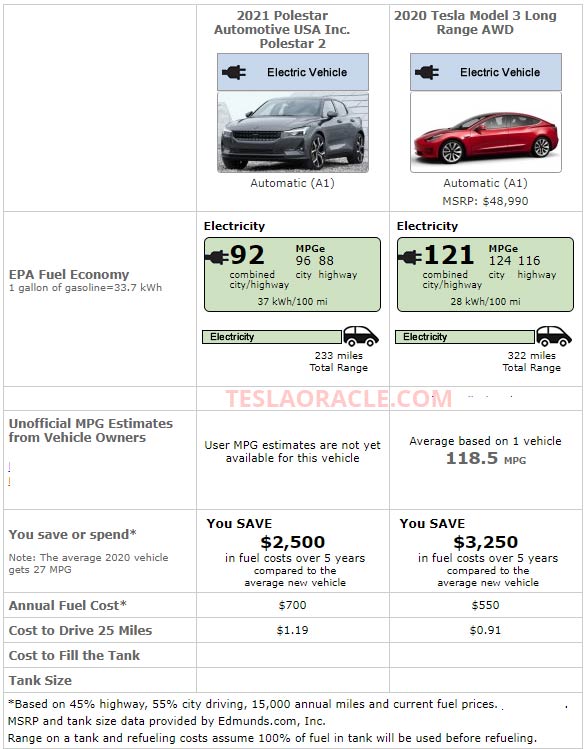My friend Ian Pavelko aka Mad Hungarian was roaming in his Tesla Model 3 Performance which he calls ‘MAGNETO’ — when he got a chance to check out a Polestar 2 EV, initially dubbed as the ultimate Tesla killer.
Matt St-Pierre who is an automotive journalist at Motor Illustrated, called Ian yesterday to tell him he’s getting his hands on a Polestar 2 for a day. Matt brought Polestar 2 to Ian’s office in Vaudreuil-Dorion QC, just outside of Montreal.
Ian took some nice pics of both the cars together and as I have an unlimited copyrights permission from Ian that I am going to take advantage of to the fullest, let’s look at these electric beasts.


The Polestar 2 seen in these pics is top of the line Performance variant with the following cool swag:
- Öhlins Dual Flow Valves dampers
- Optimized brake system feat.
- Brembo brakes (front)
- 20″ 4-Y Spoke Black Polished Forged Alloy Wheel
- Gold Valve Caps
- Gold Seat Belts front and rear
- High gloss black roof segment
When looking at these photos, especially the following head-to-head shot of Polestar 2 vs. Tesla Model 3, I see that the Model 3 is more aerodynamic and curvy while the Polestar 2 has bold kind of boxy curves all around.

Perhaps Polestar 2’s aerodynamics might be one of the reasons it received a range rating of just 233 miles from the EPA. That’s 89 miles less than the Model 3 Long Range AWD’s 322 miles of EPA estimated range rating.

Ian’s Polestar 2 Review
Ian is an active Tesla Community member and one of the earliest Tesla Model 3 owners in Canada. He also wrote a detailed story of how he took Magneto for a nighttime snow rally in Canada.
While I was talking to him, he told me the following about his experience with the Polestar 2:
ll let Matt speak to the precise differences in the driving dynamics, but quick observations from him coupled with my time as a passenger reveal that this car definitely has a heftier/more solid feel to it, and that comes across in both the positive and negative sense of the word.
You can definitely appreciate how bank-vault like the doors are when you close them.
They’ve done a good job isolating road noise and providing a comfortable ride despite the 20″ low-profile performance tires, which of course I think Tesla has managed pretty well too.
However, the Polestar Performance package does offer the very nice ability to adjust the damper settings, a big plus even if it has to be done manually from the underside in front and inside the trunk in the rear of the car.
It seems to have a good, stable grip but it isn’t anywhere as nimble or agile feeling as Model 3. If you like that traditional hewn-from-stone, stable Volvo feel you’ll love it, personally I prefer the sports-car-like quickness that the 3 has which belies it weight it in all but the slowest, tightest maneuvers.
Only thing I’m really jealous of? Those Performance package brakes. Even with all the recent mods, I did to mine to improve pedal feel, Matt says the Polestar ones feel much more solid. Judging by the size alone of the components they definitely look up to some serious track work.
Interior
The interior is of course much more traditional than that of the Tesla Model 3 but still has a good size multi-function center screen with rapid response, so it’s a nice blend of old and new worlds.
It definitely looks/feels a little more upmarket inside than the 3, although now that I’ve grown so accustomed to the elegant simplicity of the 3’s layout I can also say as pretty as it is the Polestar’s (and just about everything else on the road these days) interior now strikes me as a bit busy.
Verdict
Personally there’s just about nothing else on the road that would pry me out of Magneto. But the Polestar 2 is a very impressive piece of kit. Overall I think it’s a fantastic addition to the EV field that will help broaden appeal and bring in some new buyers. In that regard alone it’s a win.
Ian Pavelko aka Mad Hungarian and the Master of MAGNETO.
If you guys are wondering which wheels are on the Model 3 Performance in the pics? These are Fast Wheels EV01, which Ian also posted a detailed article for us last year.
Polestar 2 Video Review
Stay tuned for more interesting Tesla stories, follow us on Google News | Flipboard | RSS (Feedly).
Related:
- Tesla FSD v13 handles its first accident safely where human drivers failed (video)

- Tesla Cybertruck birthing tunnel (Cybertunnel) at Giga Texas is headed for completion

- Tesla (TSLA) begins wide release of FSD v13 to HW4 vehicles, Holiday Update to follow in a few days

- Static fire test of Flight 7 Starship pushes SpaceX one step closer to the launch

- Tesla rolls out FSD v13.2.1 to early access Cybertruck owners and HW4 cars

- Tesla HW4 vehicles are still waiting for the Holiday Update and FSD v13 wide release




The range for the Model 3 is stated as 332 mi but it’s actually 322 mi.
It’s corrected, thanks for the feedback!
EPA tests are done with the car stationary on a dyno, so aero doesn’t enter into the calculations. The big difference is puzzling to me too. The EPA driving profile doesn’t have fast accelerations or high speed driving, so this would tend to minimize I squared R losses due to high current draw from the battery. That leaves DC/AC motor inverter efficiency, motor AC drive waveforms, motor design (induction? PMSRM?), reduction gearbox efficiency, wheel bearings, dragging brakes, and tire rolling resistance as contributing factors. But still, 90 miles difference on essentially the same battery capacity? Something isn’t adding up.
Thanks for enlightening, agree 90 miles is a big difference, Volvo is making a mistake somewhere, software?